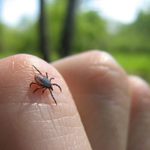Control Bugs
Updated: Apr. 23, 2020Our collection of tips may help you find a bug-busting solution

Wasps are chasing me around!
I’m getting buried alive by box elder bugs
Help! Ants are eating us out of house and home!
CAUTION!
- Don’t use bait or traps where kids or pets can get at them.
- Federal law requires insecticides to be labeled with at least one of three words: Danger, Warning or Caution. Try to avoid using products labeled with the word “Danger.”
- In general, avoid insecticides that are effective only if sprayed over a wide area. They provide minimal contact for bugs and maximum contact for people.
- If you use an insecticide indoors, make sure it’s explicitly labeled for indoor use.
Carpenter bees are hammering me
Yellow jackets are dive-bombing me
Look, we won’t kid you. Yellow jackets, a type of wasp, have the human race beat. Those big hummers that try to take away your hamburger when you eat outside are almost invincible. You can kill their underground nests by pouring lots of soapy water down the hole, if you’re lucky enough to find it. And you can eliminate outdoor sources of food and water—uncovered garbage cans, pet dishes, drippy faucets. For above-ground nests, try an aerosol wasp and hornet insecticide.
Aargh…roaches!
Running across my kitchen floor! Scientists say that for every cockroach you see, there are 100 to 600 more hiding in cracks and under your dishwasher and refrigerator. Now don’t you feel better already?
Getting rid of their food is the first step in getting rid of them. Clean up every speck and crumb—from shelves, drawers, pantry, under appliances, under the sink. Store any accessible food in plastic containers. Equally important: Remove the roaches’ water supply. Fix leaky sink traps and drippy faucets. Elevate Rover’s water dish. Eliminate damp dish towels, sponges and scrub pads. Sealed bait containers like Roach Motel are most effective. Boric acid pesticide powder also works. Just sprinkle it lightly into all cracks and crevices. It’s long-lasting and relatively nontoxic. Look for it at hardware stores and home centers.
We don’t recommend spray insecticides; they’re quite toxic for use around a kitchen, and not very effective. Many roaches are immune to them.
Meal moths are making me sick!
Could these things be termites? Eating my house?
You find a swarm of ant-like bugs with wings inside your house or on the siding. You think it could mean trouble, and you may be right. They might be carpenter ants or they might be termites. Both will eat your house. And in both cases, the ones you see are reproductive individuals leaving the nest. You can tell the species apart this way: Carpenter ants have a pronounced “waist” and back wings that are shorter than the front wings (not shown).
You can usually deal with carpenter ants yourself: Find the working ants. They’re large and black. Find the nest and use insecticide directly on it, or use bait. Be sure either product is specifically labeled for carpenter ants. Then fix the moisture problem that gave them their cozy habitat; it’s the wet wood that attracts them.
But if you do have termites… don’t mess with them. Call a state-certified pest management professional—even if you’re just guessing that they’re termites. A termite inspection will cost a little, but repairing termite damage could cost you thousands. A pest professional’s work is usually guaranteed and normally includes a reinspection every year after treatment.
Termite signs: Here’s what to look for:
- Mud tubes, which many types of termites use to travel across house foundations. They move from the soil where they nest to the wood in the house where they dine.
- Swarms of flying termites, or piles of wings, especially on windowsills.
- Hollowed wood near the ground that you can poke a screwdriver into. You may find it riddled with termite galleries, even though you may not see the termites. Check decks, fences and other outdoor structures, firewood, wood shingles, and around pipes, cracks and joints in the foundation.
- Piles of fecal pellets from drywood termites (if you live in Arizona, Southern California or on the Gulf Coast). Pellets, less than 1/16 in. long, look like small seeds.
Reduce the risk of termites by eliminating all wood-to-soil contact around the house.
Oh, no! My dog has fleas!
Any outdoor pet can pick up fleas from chipmunks, squirrels or rabbits. But you don’t want them on you. Adult fleas may target your pet, but they live in your space too—on the floor, ground or bedding material—wherever your pet hangs out. That’s why it’s essential to treat those areas as well as the animal.
First, thoroughly vacuum the carpet. Wash bedding in hot water. You might need to steam-clean carpeting. Outdoors you can use insecticide.
Treat your pet with one of the various flea killers available at pet stores, or better, ask your vet about one of the flea killers given orally. These products get into your pet’s bloodstream, and when fleas bite, they become infertile. Eventually the whole population dies. Unlike other flea-killer powders, the oral treatments are completely harmless to mammals.
What on earth is this critter?
What do you do if you’ve got a swarm or colony of bugs that you can’t identify, and they’re a nuisance, or you suspect they may be harmful? Your local county extension service may be able to help. Or try the National Pest Management Association’s “discussion forum” at www.pestworld.org. You can also check with a pest management professional.
Required Tools for this Project
Have the necessary tools for this DIY project lined up before you start—you’ll save time and frustration.
- 4-in-1 screwdriver
- Caulk gun
- Flashlight
- Shop vacuum
Required Materials for this Project
Avoid last-minute shopping trips by having all your materials ready ahead of time. Here’s a list.
- Ant bait and traps
- Boric acid
- Caulk
- Detergent
- Flea treatments
- General insecticide
- Plastic or glass container
- Wasp and hornet killer












